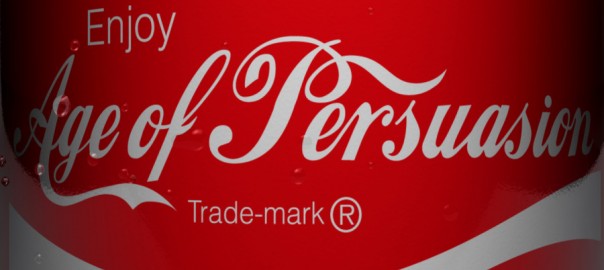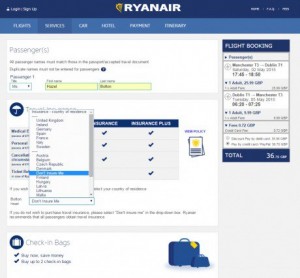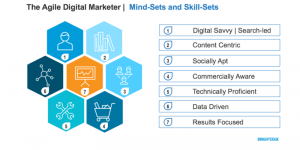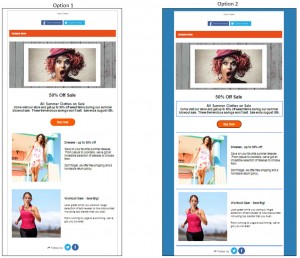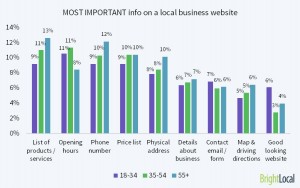Whether you’re looking to generate leads or increase sales, having your PPC ads direct visitors to persuasive landing pages is an excellent way to grow your business. However, genuinely persuasive copywriting is challenging, and it takes a great deal of nuance and subtlety to spur your prospects into action.

In today’s post, I’ll be examining three persuasive techniques you can use for landing page optimization, five “power words” for persuasion and what makes them so effective, and how you can use these tactics to make your prospects do what you want them to.
Hook, Line, and Sinker: Grabbing Your Prospects’ Attention
Imagine you’re at a networking event. You’re sipping a crisp glass of Chardonnay, waiting for a breakout session on securing series A financing for educational software companies to begin, when a well-dressed man in his mid-30s walks straight up to you. He grabs your hand, shakes it just a little too hard, before starting to talk about his new startup. No introduction, no conversational pleasantries – he just dives right into his elevator pitch.
Regardless of how revolutionary or impressive it might be, it doesn’t matter what the guy’s startup is actually working on. Why? Because he didn’t bother to grab your attention before launching into his monologue. Believe it or not, this is a mistake made by many marketers on their landing pages.

Some marketers assume that just because someone clicked an ad, the prospect is automatically interested in whatever it is they’re selling. Although that can be true to an extent, it shouldn’t be taken as a given. As a result, many marketers do exactly what the guy at the networking event did – they start trying to impress or persuade you without making sure you’re actually interested first.
Mastering ‘The Hook’
Even if your product or service is truly incredible, it’s crucial to get your prospects’ attention before trying to persuade them. The most effective way to do this is to manipulate their emotions.
We’ve said it before, but it bears repeating – people don’t want to buy things, they want to solve their problems. Understanding and leveraging this principle is important in your ad copy, but it becomes even more important on your landing pages. If you can exploit the promised emotional payoff of solving a prospect’s problem with your product or service, they’re as good as converted.
Hooks can take many forms. Let’s look at an example that uses fear as its hook.

Overall, this landing page isn’t actually that great, but we won’t focus on its shortcomings right now. What I want to highlight is the language used in the banner image at the top of the page. This example demonstrates how the inclusion of a single word can make a powerful impact.
Imagine if the banner copy simply read, “Make Home Feel Safe.” Not particularly powerful or persuasive, right? However, by adding “Again” to the copy, the company is actually manipulating the emotions of its prospects. In this context, the word “again” implies that home used to feel safe, but doesn’t anymore. This copy also implies that, by choosing a SimpliSafe home security system, homeowners will feel safe again, which is the real emotional payoff prospects are looking for.
This example of persuasive copywriting does exactly what it’s supposed to – grabs SimpliSafe’s prospects’ attention (in this case, by manipulating their fears), prompting them to read more about SimpliSafe’s services.
Using Sensory and Aspirational Language
You may recall that, earlier in this post, I used an example of a bold, overly confident man striding up to you at a networking event to illustrate a point.
I could have simply stated that most marketers go straight into persuasion mode without grabbing your attention first, but I’d wager that the technique I used was far more effective. Why? Because I made you use your imagination.
By including sensory adjectives such as “crisp” in relation to the Chardonnay, I made it easier to imagine being there, sipping the wine, before being approached by the cocky entrepreneur. My primary goal was to create a strong connection in your mind between the imagined scene and the point I was making.
Admittedly, using sensory language to create scenes in your prospects’ minds can be difficult on landing pages. After all, your prospects don’t want to read a story, they want to learn how your product or service can solve their problems. However, that doesn’t lessen the impact that using evocative language to paint pictures in your visitors’ minds can have, or mean that using this technique is impossible on a landing page.
Painting Pictures with Words
Let’s say you’re looking for a company to remodel your kitchen. There are likely several practical considerations you’re looking to address, such as insufficient counter space or poorly-fitted cupboards. However, many people who want their kitchens remodeled also want to create an entirely new space in their home; a place they can not only cook, but spend time with their family and friends.
Let’s take a look at an example that addresses the aspirational qualities of this type of prospect through persuasive copywriting on their landing page.

This landing page, from NEDC Design & Construction, utilizes both sensory and aspirational language to great effect.
First, the introductory copy draws a stark contrast between the kitchens of previous decades (“No longer does apron-clad Mom cook alone as the family waits in another room.”), which not only implies NEDC’s progressive, modern approach to kitchen design, but also leverages the emotional response that this memory will create in many prospects’ minds.
The copy then switches gears to take a more tactile approach by using a combination of sensory and aspirational language (“Today, you’re just as likely to see a couple cooking together, or the whole family pitching in on Thanksgiving dinner, or friends gathered around sipping wine as you finish making tapas.”). The copy puts you right there in your new kitchen, sipping wine and making tapas with friends, or preparing the cranberry sauce while the Thanksgiving turkey cooks in the oven.

In addition to creating a powerful emotional response, this approach can also spur your prospects into action. By helping your visitors imagine a possible future scenario, you allow them to step out of their present – and the problem they’re trying to solve – making your solution significantly more appealing.
The Power of Connecting Language
Humans are inherently tribal in nature. For millennia, we have formed tight-knit groups to help us survive. Although we’ve come a long way since we huddled around crude fires brandishing rocks at outsiders, we still instinctively form these groups, whether it be identifying with others of a similar social standing or forming emotional attachments to certain brands (the Apple vs. everyone else dichotomy is a prime example of this principle).
Simply put, connecting language is the concept of emphasizing the notion of “us vs. them.” This can be a powerful technique when leveraged appropriately, as it can strengthen brand loyalty, serve as a trust signal, and deepen prospects’ emotional attachment to a product or service. However, it’s most common to see marketers use connecting language to create a stronger positive perception between the prospect and the brand. Let’s take a look at this type of persuasive copywriting in action.
Us Vs. Them
Legal specialists often use connecting language in their landing pages. Of course, the adversarial nature of most courtroom situations – especially divorces and other family law cases – makes this an ideal opportunity to use connective language.

In the example above, the copy is interspersed with connecting phrases such as “we understand,” and “that’s exactly when you need good advice to make the right decisions for your future.” Words such as “we,” “our,” “you” and “your” can be highly motivational when used correctly, making this landing page an excellent example of how connecting language can be used to great effect.
Connecting language also lends itself very well to the introduction of trust signals in an easy, natural way. Although many companies are eager to tell prospects about themselves, doing so without sounding forced or overly promotional can be difficult. It’s a lot easier to introduce these facts when using connecting language. For example, the copy in the second paragraph not only states how many years of experience the firm has in handling these types of cases, but also mentions that they often advocate for negotiation over more aggressive litigation tactics, both of which could be highly persuasive to someone facing a potentially bitter court battle.
‘Power Words’ 101
Now that we’ve looked at some specific types of persuasive copywriting you can use on your landing pages, let’s take a look at some of the most common “power words.” These words, when used correctly, can take make your copy significantly more compelling, but it’s important to understand why they’re so effective.

Power Word #1: ‘You’
When writing landing page copy, one of the most basic assumptions you can (and maybe even should) make about your prospects is that they’re selfish. Even the most thoughtful, considerate people still want to know how your product or service directly benefits them, and apparently selfless acts, such as donating to charity, still make us feel good about ourselves.
“You” is one of the most powerful words you can use in your copy. When we read the word “you,” our brains respond in a similar way as they do when we hear our own names (specifically, heightened activity in both the anterior and posterior regions of the brain, in case you’re interested).
Words such as “you” and our names trigger specific responses in the brain that appeal directly to our sense of identity, making them a powerful way to connect with your prospects. This approach also reinforces prospects’ desire to be treated as an individual, rather than just another customer.
Power Word #2: ‘Easy’
If we assume that most people are selfish, why not assume they’re lazy while we’re at it?
We’ve already established that prospects want to solve problems, not buy things. It stands to reason that most people will choose the path of least resistance when solving a problem rather than make things difficult for themselves. This is why “easy” is our second power word.

If you can solve a prospect’s problem and make it as easy as possible for them to do so, you’re onto a winning formula. People want to solve their problems, but they also want to do as little as possible to accomplish their goals.
If your product or service is genuinely easy to use, say so in your landing pages. Better yet, show them how easy it is. Use copy that helps them imagine how much easier their life would be by using your product or service, and make it as easy as possible for the visitor to convert.
Power Word #3: ‘Save’
When it comes to committing to a purchase, most prospects are looking to minimize two things: how much it will cost them, and how long it will take. Even if time and money aren’t your prospects’ primary concerns, the word “save” has powerful implications that can make your landing page copy much more persuasive.
![]()
Whatever your product or service can help your prospects save, frame it within the context of the emotional payoff they crave. This technique is what makes services such as TurboTax so appealing; it promises one-click filing, auto-populating forms, and as little data entry as possible, saving the user not only time, but effort. Combine this with the powerful financial incentive to file tax returns early, and you’re looking at a very persuasive proposition.
Power Word #4: ‘Results’
To the undecided prospect, ambiguity is the enemy. Why waste time or money on something that may not work? Sure, you might lose weight by drinking this delicious protein shake – but then again, you might not. The word “results” can offset prospects’ hesitation to commit and nudge them gently over the line and convert.

The best salespeople know to let the product do the talking for them, so whatever you’re trying to sell, include real examples of how your product or service has helped existing customers. This not only serves as a trust signal, it also proves that your product does what it says it does. Tread carefully when framing results in this manner, though, as intentionally misleading your prospects isn’t just unethical, it can also be potentially damaging to your brand.
Power Word #5: ‘Guarantee’
Similarly to “results,” the word “guarantee” can be one of your most powerfully persuasive tools as a copywriter.
Just as many prospects are averse to ambiguous “solutions” to their problems, they’re even more wary of the possibility of losing something, whether it be time, money, or something else. That’s what makes the word “guarantee” so powerful – when used correctly, it effectively removes the risk of at least trying whatever you’re selling.

However, just as you have to be careful with the word “results,” you should be even more cautious when using the word “guarantee.” If you promise something, you had better be ready to deliver. In the case of money-back guarantees, make it as easy as possible (see Power Word #2). Don’t make assertions about anything you can’t back up, and don’t make promises you can’t keep.
Choose Your Words Carefully
Writing genuinely persuasive landing page copy can be tough, but it can have a tremendous impact.
If you’re not satisfied with your conversion rates, take a look at what your landing pages are saying. Sometimes, rephrasing what you’re trying to say can make a big difference. Hopefully, these examples have given you some ideas for possible changes to your own landing page copy.
(416)
Report Post